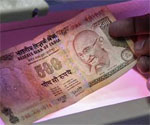
New Delhi, July 8: Seeking to spread awareness among public about fake notes, the Reserve Bank has launched a website explaining ways to detect counterfeit notes.
With a tagline 'Pehchano Paise Ki Boli, Kyunki Paisa Bolta Hai', the website -- www.paisaboltahai.rbi.org.in -- gives visual presentation with pointers on currency notes of 10, 20, 50, 100, 500 and 1,000 rupee denominations.
Consumers have the option to download posters of these currency notes, which can be used as reference to identify counterfeit notes. A documentary film on it can also be downloaded.
The link for this website is available on RBI's main website as well.The site also gives details of the number of fake currency notes detected.
RBI said considering there were 64,577 million pieces of banknotes in circulation as on March 31, 2011, the detection of forged notes during 2010-11 was to the tune of 6.74 pieces per million pieces of banknotes in circulation.
In the past as well, the Reserve Bank has come out with various notifications warning against circulation of counterfeit currency notes.
Referring to the fake currency notes in circulation, RBI Governor D Subbarao said in Kozhikode on Friday that the government and police are taking several measures to deal with the menace.
He emphasised the need to educate people on ways to distinguish fake currency notes from the genuine ones.






Comments
Add new comment